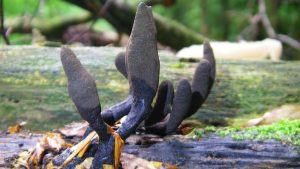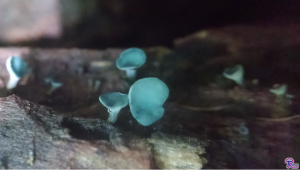#150: Asterophora lycoperdoides
This is one of the strangest mushrooms on Earth. It is a gilled mushroom that parasitizes other mushrooms, which already makes it a rarity. Even less common, Asterophora lycoperdoides reproduces primarily through asexual “” This mushroom is commonly known as the “Star-Bearing Powder Cap” or the “Powdery Piggyback.” The former name is more common in the United States, while the latter is primarily used in the United Kingdom.
The most striking feature of A. lycoperdoides is the large, blackened, decaying mushroom from which it fruits. If not for its unique substrate, most mushroom hunters would probably not give this “little brown mushroom” a second look. Once you do stop for a closer look, it quickly becomes clear that you’ve found something really special.
A. lycoperdoides is quite small, growing only 2-5 cm (0.8-2 in) tall and 1-2.5cm (0.4-1 in) wide. When young, the pileus is spherical, whitish and slightly lumpy. As the mushroom matures, the cap expands to become convex and develops a brown, powdery surface. Unlike most other mushrooms, A. lycoperdoides produces the bulk of its spores from the top of its cap. The powder on the cap is actually a thick layer of asexual spores. It seems that the powdery spores reminded the mycologist who named this species of puffball spores, since “lycoperdoides” means “like Lycoperdon” (Lycoperdon is the primary genus of puffballs).
Underneath the cap, this mushroom features partially-formed gills. The whitish to greyish gills radiate outward from a central stipe and are pointed at the edges like true gills, but they don’t look fully formed. In relation to their height, the gills are not nearly as thin as normal gills should be. This makes them look more like veins than true gills. When young, a few basidia can be found on the gills. These produce sexual spores that are elliptical, smooth, and white en masse (though obtaining a spore print from the gills is very difficult).
The stipe is probably the least interesting part of this mushroom. It is usually less than 1cm in width and maintains about the same with for its entire length. Its texture is dry and smooth, but it may be finely velvety. The stipe can range in color from whitish to brownish and attaches to thin cords at its base that are about the same color. On the inside, the mushroom features white to brown flesh. It has a mealy odor and taste.
The spores produced from the cap of A. lycoperdoides are technically not spores at all. They are produced using neither the pathway for sexual spores nor the one for asexual spores, so mycologists do not count them as true spores. Instead, mycologists call these “chlamydospores.” The chlamydospores are thick-walled, asexual cells formed from swollen and twisted tips of hyphae. Like true spores, these are released from the main body of the fungus and dispersed by the wind. In A. lycoperdoides, the chlamydospores develop thick cell walls with pointy, star-like projections (which accounts for the “Astero-” in the genus name). These ornamentations are arranged in a chaotic manner due to the haphazard process of chlamydospore formation. Many other fungi make chlamydospores, but in most fungi they are much less abundant. However, mushroom-forming basidiomycetes almost never reproduce asexually. This makes A. lycoperdoides an incredibly unusual mushroom.
This rare mushroom is found growing parasitically on only the remains of mushrooms in the genera Russula and Lactarius. It is most commonly found on russulas that readily bruise when injured, such as R. nigricans. A. lycoperdoides is most abundant following wet weather, but tends to be patchy in distribution. As currently defined, it lives in North America, Europe, and Asia, where its range extends at least as far south as central India.
There are a few other gilled mushrooms that parasitize other mushrooms, but A. lycoperdoides is the only one with a powdery cap and partially-formed gills. The genus Asterophora contains one other mushroom, A. parasitica, which may look like A. lycoperdoides when both are young. It soon becomes clear, however, that A. parasitica has fully developed gills and its cap does not become powdery with chlamydospores.
See Further:
http://www.mushroomexpert.com/asterophora_lycoperdoides.html
http://botit.botany.wisc.edu/toms_fungi/dec2005.html
http://www.rogersmushrooms.com/gallery/DisplayBlock~bid~5576.asp

![#119: Pisolithus arrhizus, the Dyeball [Archived]](https://www.fungusfactfriday.com/wp-content/themes/hueman/assets/front/img/thumb-medium-empty.png)





![#011: Characteristics of Kingdom Fungi [Archived]](https://www.fungusfactfriday.com/wp-content/themes/hueman/assets/front/img/thumb-small-empty.png)


